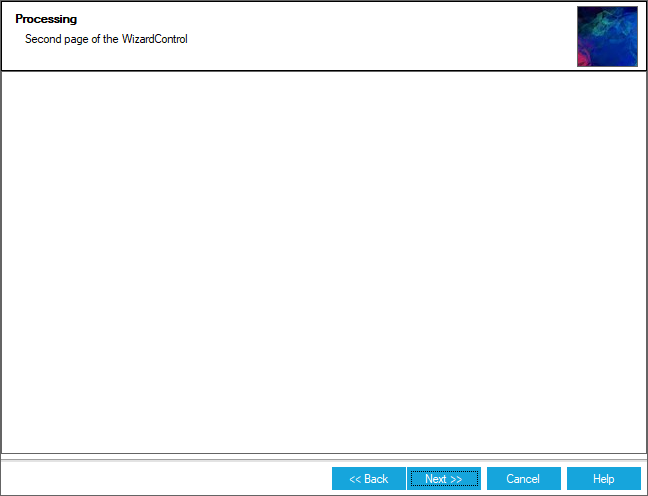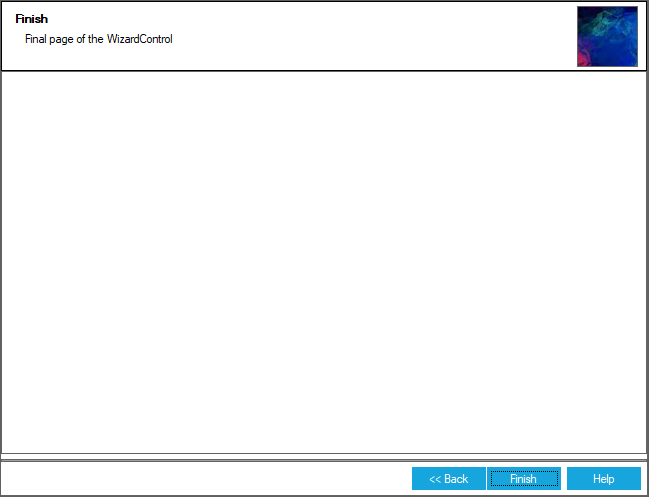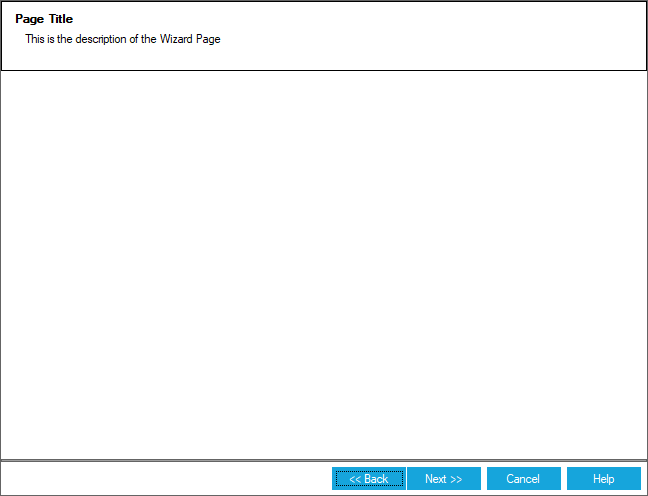Getting Started with Windows Forms Wizard Control
25 Nov 20258 minutes to read
This section describes how to add WizardControl in a Windows Forms application and overview of its basic functionalities.
Assembly deployment
Refer control dependencies section to get the list of assemblies or NuGet package needs to be added as reference to use the control in any application.
Please find more details regarding how to install the nuget packages in windows form application in the below link:
Creating simple application with WizardControl
You can create the Windows Forms application with WizardControl control as follows:
- Creating project
- Adding control via designer
- Adding control manually using code
- Configure WizardPages
Creating the project
Create a new Windows Forms project in the Visual Studio to display the WizardControl with functionalities.
Adding control via designer
The WizardControl control can be added to the application by dragging it from the toolbox and dropping it in a designer view. The following required assembly references will be added automatically:
- Syncfusion.Grid.Base.dll
- Syncfusion.Grid.Windows.dll
- Syncfusion.Shared.Base.dll
- Syncfusion.Shared.Windows.dll
- Syncfusion.Tools.Base.dll
- Syncfusion.Tools.Windows.dll


NOTE
In .NET Core, the Wizard control’s Collection Editor displays the title “ControlProxy`1 CollectionEditor” instead of “WizardControlPage CollectionEditor.”
This is a known issue and does not affect functionality.
For more details, see GitHub Issue #14049
Adding control manually in code
To add control manually in C#, follow the given steps:
Step 1 : Add the following required assembly references to the project:
* Syncfusion.Grid.Base.dll
* Syncfusion.Grid.Windows.dll
* Syncfusion.Shared.Base.dll
* Syncfusion.Shared.Windows.dll
* Syncfusion.Tools.Base.dll
* Syncfusion.Tools.Windows.dll
Step 2 : Include the namespaces Syncfusion.Windows.Forms.Tools.
using Syncfusion.Windows.Forms.Tools;Imports Syncfusion.Windows.Forms.ToolsStep 3 : Create WizardControl control instance and add it to the form.
WizardControl wizardControl1 = new WizardControl();
this.wizardControl1.Style = Theme.Metro;
this.Controls.Add(wizardControl1);Dim wizardControl1 As WizardControl = New WizardControl()
Me.wizardControl1.Style = Theme.Metro
Me.Controls.Add(wizardControl1)Add wizard page into WizardControl
Create an instance of WizardContainer, add it to WizardControl and set it as WizardPageContainer of WizardControl. WizardControlPages can be added to using WizardPages collection property.
// Create instance of page elements
WizardControlPage wizardControlPage1 = new WizardControlPage();
WizardControlPage wizardControlPage2 = new WizardControlPage();
WizardControlPage wizardControlPage3 = new WizardControlPage();
// configure pages
this.wizardControlPage1.Title = "Welcome";
this.wizardControlPage1.Description = "First page of the WizardControl";
this.wizardControlPage1.BackVisible = false;
this.wizardControlPage2.Title = "Processing";
this.wizardControlPage2.Description = "Second page of the WizardControl";
this.wizardControlPage3.Title = "Finished";
this.wizardControlPage3.Description = "Final page of the WizardControl";
this.wizardControlPage3.NextVisible = false;
this.wizardControlPage3.CancelVisible = false;
this.wizardControlPage3.FinishVisible = true;
this.pictureBox1.Image = ((System.Drawing.Image)(resources.GetObject("pictureBox1.Image")));
this.wizardControl1.Banner = this.pictureBox1;
// Add pages into wizard Control
this.wizardControl1.WizardPages = new Syncfusion.Windows.Forms.Tools.WizardControlPage[] {
this.wizardControlPage1,
this.wizardControlPage2,
this.wizardControlPage3};' Create instance of page elements
Dim wizardControlPage1 As New WizardControlPage()
Dim wizardControlPage2 As New WizardControlPage()
Dim wizardControlPage3 As New WizardControlPage()
' configure pages
Me.wizardControlPage1.Title = "Welcome"
Me.wizardControlPage1.Description = "First page of the WizardControl"
Me.wizardControlPage1.BackVisible = False
Me.wizardControlPage2.Title = "Processing"
Me.wizardControlPage2.Description = "Second page of the WizardControl"
Me.wizardControlPage3.Title = "Finish"
Me.wizardControlPage3.Description = "Final page of the WizardControl"
Me.wizardControlPage3.NextVisible = False
Me.wizardControlPage3.CancelVisible = False
Me.wizardControlPage3.FinishVisible = True
Me.pictureBox1.Image = (CType(resources.GetObject("pictureBox1.Image"), System.Drawing.Image))
Me.wizardControl1.Banner = Me.pictureBox1
' Add pages into wizard Control
Me.wizardControl1.WizardPages = New Syncfusion.Windows.Forms.Tools.WizardControlPage() { Me.wizardControlPage1, Me.wizardControlPage2, Me.wizardControlPage3}


Configure BannerPanel
Controls can be added to header of the WizardControl using BannerPanel property where panel containing the desired controls is added.
// Create instance of controls to be added
GradientPanel gradientPanel1 = new GradientPanel();
Label label1 = new Label();
Label label2 = new Label();
this.label1.Text = "Page Title";
this.label2.Text = "This is the description of the Wizard Page";
this.gradientPanel1.Controls.Add(this.label1);
this.gradientPanel1.Controls.Add(this.label2);
// Adding it to WizardControl
this.wizardControl1.Controls.Add(this.gradientPanel1);
this.wizardControl1.Title = this.label1;
this.wizardControl1.Description = this.label2;
this.wizardControl1.BannerPanel = this.gradientPanel1;'' Create instance of controls to be added
Dim gradientPanel1 As New GradientPanel()
Dim label1 As New Label()
Dim label2 As New Label()
Me.label1.Text = "Page Title"
Me.label2.Text = "This is the description of the Wizard Page"
Me.gradientPanel1.Controls.Add(Me.label1)
Me.gradientPanel1.Controls.Add(Me.label2)
'' Adding it to WizardControl
Me.wizardControl1.Controls.Add(Me.gradientPanel1)
Me.wizardControl1.Title = Me.label1
Me.wizardControl1.Description = Me.label2
Me.wizardControl1.BannerPanel = Me.gradientPanel1
Change navigation buttons visibility
You can change the visibility of the Back, Cancel, Next, Help and Finish navigation buttons in the wizard control and wizard page. This is done by using the BackVisible, CancelVisible, NextVisible, HelpVisible and FinishVisible properties respectively.
this.wizardControlPage1.BackVisible = true;
this.wizardControlPage1.NextVisible = true;
this.wizardControlPage1.CancelVisible = true;
this.wizardControlPage1.HelpVisible = true;
this.wizardControlPage1.FinishVisible =false;Me.wizardControlPage1.BackVisible = True
Me.wizardControlPage1.NextVisible = true
Me.wizardControlPage1.CancelVisible = True
Me.wizardControlPage1.HelpVisible = true
Me.wizardControlPage1.FinishVisible = False